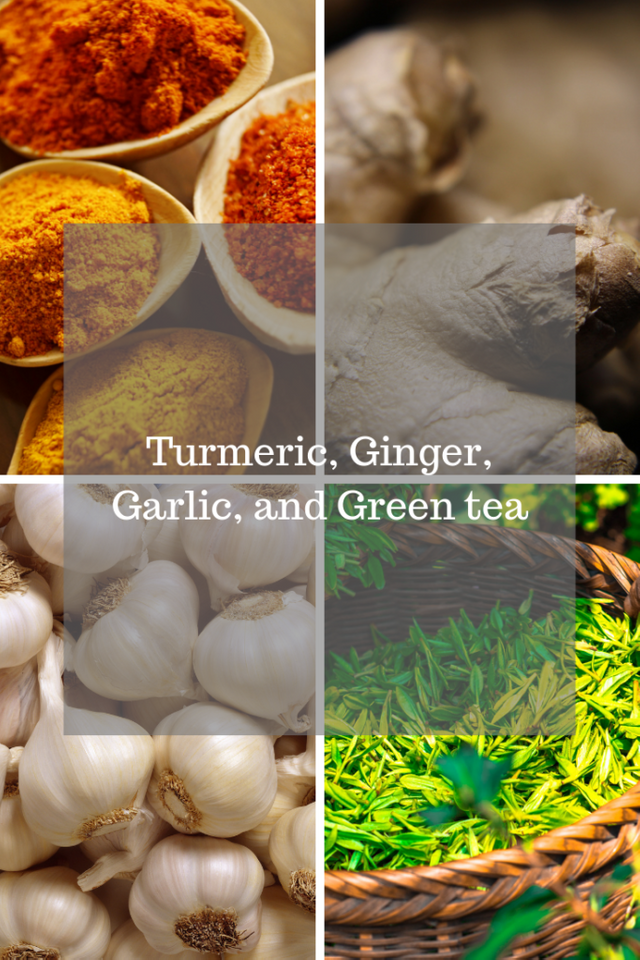Turmeric, Ginger, Garlic, and Green tea


Turmeric is related to ginger and native to India. The dried and ground rhizome is used as a spice all over Asia and as a dye for foods and fabric.
The rhizome was first used as a dye and later as medicine and has been in use for thousands of years. Turmeric is a perennial that can grow up to 3 feet tall, the foliage is large and attractive. The plant grows wild throughout south and southeast Asia in the forests.
The plant has also had an important role in various religions in India as well, Hindu monk robes were dyed with it, the Tamil religion associated its colour with the sun and crown chakra. It also plays a role in Hindu weddings.
Currently, there are thousands of studies that have been done on turmeric and its components! In 1280 Marco Polo marvelled at turmeric’s similarity to saffron.
India produces most of the world’s crop of turmeric and consumes 80% of it.
At home, it is easiest to take turmeric in water followed by a source of fat, which increases the absorption rate for turmeric. It has been traditionally used for managing arthritis and a host of various digestive issues including IBS. Breastfeeding mothers can also take turmeric to increase milk supply. However pregnant women should avoid medicinal doses because turmeric has been used to encourage menstruation. Food level amounts are generally considered safe.
Uses:
Internally it can be used for boosting milk production, reducing inflammation and pain, encourages bowel movements, boosts immune function.
Externally a paste can be applied to wounds to help with infection and speed healing (it will stain the skin).
**Cautions: **
Pregnant women should avoid it because it increases milk production and encourages menstruation.
Possible drug interactions;
Blood-thinning medications including but not limited to warfarin (Coumadin), clopidogrel (Plavix), aspirin.
Acid reducers including Cimetidine (Tagamet), Famotidine (Pepcid), Ranitidine (Zantac), Esomeprazole (Nexium), Omeprazole (Prilosec), Lansoprazole (Prevacid).
Diabetes medications can also have interactions with turmeric.
**First aid: **
If a pregnant woman has taken a medicinal dose of turmeric monitor closely for signs of possible miscarriage.
If a possible drug interaction is suspected go to the hospital immediately for monitoring.
No known cautions for children. Excessive pooping may occur over a 24hr period if a child ingests a medicinal quantity.

Long known as highly beneficial for its digestive properties and ability to reduce inflammation in the body, people throughout Asia have been using this rhizome as medicine for thousands of years. Ginger originated in southern China and spread to other parts of Asia, as well as the Caribbean and West Africa. The plant itself is very pretty and can make a good ornamental choice for some gardeners.
The tea is my first choice for indigestion, illnesses relating to the stomach, or for ulcers. It is also gentle enough that it can be given to a toddler with an unhappy tummy.
As a spice, the economic power ginger commanded as far back as 200 B.C.E. was significant. Literature from all over Asia, Europe, and the Middle East wrote of its impact.
The healing properties were considered so important that India and China considered a tea made from it to be a gift from the gods. Maybe this is because it is considered an aphrodisiac!
The total global production of ginger in 2013 was 2.1 million tonnes with 33% of that coming from India alone.
There isn’t much else I can say but I can tell you I never allow myself to run out of fresh ginger in my kitchen. A cup of ginger tea when my stomach isn’t happy is a godsend.
I do have to mention that there is an essential oil of ginger that you may find. This is not a beginner oil, use caution in your application and dilution of this essential oil if you choose to use it.
**Uses: **
As a tea or spice for easing digestion and boosting immune function. It will also reduce inflammation and as a result, pain is relieved. The tea can also be used for reducing fever. The herb can help reduce blood pressure and help expel parasites.
**Cautions: **
Blood-thinning medications:
Ginger may increase the risk of bleeding. Warfarin (Coumadin), clopidogrel (Plavix), or aspirin.
Diabetes medications:
Ginger can lower blood sugar. This can increase the risk of hypoglycemia or low blood sugar.
High blood pressure medications:
Ginger can lower blood pressure, increasing the risk of low blood pressure and/or irregular heartbeat.
**First aid: **
Minor irritation may occur from handling the peeled rhizome, wash area with soap and water. Serious problems only occur if a person is allergic (extremely rare), call emergency services if an allergy is suspected.

Garlic, age-old garlic. This common kitchen ingredient is a member of the onion family, originally native to the region between China and the Mediterranean. Garlic has been cultivated for so long that pinning down the original species is tough. There are hundreds of species grown for their different properties. Typically propagation is done by planting a whole clove rather than by seed, seed propagation can hit or miss so the asexual method of using the cloves is preferred. Garlic grows easily in mild climates with lots of sun and loose, dry soil. In many places, garlic is a fundamental ingredient in the kitchen and few meals would be complete without it. Packed with nutrients and medicinal components each clove is like a tasty multivitamin in your meal. Medicinal use of garlic as the poor man's cure-all can be traced across continents for thousands of years. Classical Greek medicine documented garlic as does traditional Chinese medicine. Some of the medicinal properties supported by current research include improving cardiovascular health, reducing cancer rates in the digestive tract, antibacterial, antiviral, antifungal, and an overall immune booster. An article published within the PubMed database which focuses just on garlic concludes with the following;
"Garlic is the plant necessary in everyday life from the past until the present days. It contains active compounds that are responsible for its effect on almost every part of the human body. Garlic is an excellent tonic for the human organism. It has been used for medical treatment of everything, from ancient civilizations to date. Notwithstanding its confirmed action, in the past, it was avoided, even banned, only because of its sharp and unpleasant smell. From all of the above-mentioned data, it can be concluded that the administration of garlic should not be avoided; on the contrary, its intake should be as much as possible since it underlies human health."
As a readily available panacea, every medicine cabinet can keep garlic-infused oil for a variety of purposes. To make an infused oil you need a carrier oil like olive oil or coconut oil, a glass jar with lid, and enough peeled garlic to fill the jar.
Just pour the oil over the garlic and make sure there are no air bubbles. Leave it to sit until it smells noticeably of garlic. You can strain the garlic out and use it for cooking. The infused oil can be used for earaches for all ages, as a smelly topical antiseptic, or a rub for arthritic joints.
Uses:
Garlic oil (not the essential oil) for ear infections, arthritic joints, ect...Fresh for topical fungal infections, chewing a clove for tonsil and/or throat infections.
Cautions:
Drug interactions:
Indomethacin and other antiplatelet medications, blood-thinning medications, protease inhibitors.
**First aid: **
For contact burns simply wash with soap and water. For upset stomach from eating raw garlic activated charcoal or a digestive herb such as chamomile or ginger can be taken.

Green tea comes from the same plant as black tea (Camellia sinensis), a different variety of Camellia is grown for Indian Assam tea. The difference between all types of tea from these evergreen shrubs is in how they are processed. For black tea the leaves must go through a withering and oxidation process, some types may also be fermented or roasted.
How the plants are grown, the timing of the harvest and the method of processing can change the type of tea produced. The leaves may be harvested 3 - 4 times per year with the first harvest being the best quality.
Green teas still go through different drying and roasting methods such as sun-dried, or pan firing for artisanal methods, however most green tea goes through commercial processes which involve oven drying, steaming, or tumbling. China produces 80% of global production with Japan, Vietnam, and Indonesia following for green tea production. Most true teas use the leaves of the plant with a couple of deviations using the flowers and twig tea using the stems. Records in China indicate that the plants were first actively cultivated around 3000 years ago.
Uses:
Internally as tea or supplement to boost immune function, reduce risk of cancer, protect the cardiovascular, digestive, and bronchial systems.
Cautions:
Possible drug interactions;
Adenosine, Beta-lactam, Benzodiazepines, blood-thinning medications, beta-blockers Propranolol, and Metoprolol, chemotherapy, Clozapine (Clozaril), Ephedrine, Lithium, Monoamine Oxidase Inhibitors (MAOIs) such asIsocarboxazid (Marplan), Moclobemide (Manerix), Phenelzine (Nardil), Tranylcypromine (Parnate). Birth control pills, Phenylpropanolamine, Quinolone antibiotics such as Ciprofloxacin (Cipro), Enoxacin (Penetrex), Grepafloxacin (Raxar), Norfloxacin (Chibroxin, Noroxin), Sparfloxacin (Zagam), Trovafloxacin (Trovan). Acetaminophen (Tylenol), Carbamazepine (Tegretol), Dipyridamole (Persatine), Estrogen, Fluvoxamine (Luvox), Methotrexate, Mexiletine (Mexitil), Phenobarbital, Theophylline, Verapamil (Bosoptin, Calan, Covera- HS, Verelan, Verelan PM).
Individuals who suffer from anxiety, stomach ulcers, psychological disorders, kidney or liver problems, or heart problems should research carefully before taking green tea.
Individuals with diabetes, glaucoma, anemia, or osteoporosis should also research carefully before using green tea medicinally.
No specific cautions for babies or children.
First aid:
If a drug interaction is suspected call emergency services and explain.

Good data on the species, you always have to have them at hand, you will always have to prepare a good meal and relieve some ailment.
I reacted to turmeric with large bruises along the insides of my forearms. They lasted for weeks. So the blood thinning part is no joke. (I am not on blood thinners, nor had taken a large amount of it.)
Ginger, particularly candied ginger, worked well for air sickness for my sister and I, when nibbled in tiny amounts as needed.
Garlic's medicinal properties are best utilized by using a garlic press and allowing the results to rest for a minimum of 10 minutes. I did a post on this.
Currently consuming ALL the garlic and ginger and turmeric! I figure it's gotta be good for my hayfever/cold whatever the hell this is, right?
totally! Actually garlic tends to increase histamine production so you might want to cut back for a bit
These are main stays in our household with a morning ginger turmeric lemon Applecider vinegar and stevia toner drink, green tea after meals and lots of garlic in our cooking and raw in our pestos and guacamole! Good stuff - thanks for all the added info on them!
Congratulations @porcheberry! You have completed the following achievement on the Steem blockchain and have been rewarded with new badge(s) :
You can view your badges on your Steem Board and compare to others on the Steem Ranking
If you no longer want to receive notifications, reply to this comment with the word
STOPTo support your work, I also upvoted your post!
Always good to be reminded of the @naturalmedicine basics. :)
Leading the curation trail for both @ecotrain & @eco-alex.
Together We’re Making This World A Better Place.
Click Here To Join the manually curated trail "@artemislives" to support quality eco-green content.
@ecoTrain
This post was shared in the Curation Collective Discord community for curators, and upvoted and resteemed by the @c-squared community account after manual review.
@c-squared runs a community witness. Please consider using one of your witness votes on us here